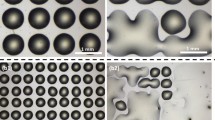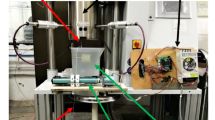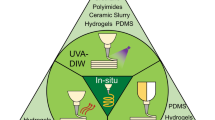Abstract
With the recent progress in inkjet technology, it has been employed to develop manufacturing processes to deposit a range of functional materials for various applications. The authors have researched the possibility of a novel inkjet-integrated process for nylon 6. The concept requires stable jetting and deposition of activator and catalyst mixtures of caprolactam. This paper reports on droplet formation characteristics of the molten mixtures in the inkjet system using high-speed imaging and quantitative image analysis. By varying the process parameters, the droplet shape and kinetics were studied in addition to the stability of droplet generation. Results showed the jetting frequency did not have an effect; and with low jetting voltages, instability occurred due to the low kinetic energy, which made the droplets vulnerable to the air motion caused by convection around the heated printhead. The catalyst mixture which had a particulate nature was also investigated for consistency, to ensure the droplet characteristics were unaffected by this. Increasing the vacuum level decreased the droplet kinetics due to the higher surface energy which existed on the meniscus, which was found to be inside the nozzle. It was possible to have satellite-free and stable droplet generation conditions.
Similar content being viewed by others
References
Le HP (1998) Progress and trends in inkjet printing technology. J Imaging Sci Technol 42:42–69
de Gans BJ, Duineveld PC, Schubert US (2004) Inkjet printing of polymers: state of the art and future developments. Adv Mater 16:203–213. doi:10.1002/adma.200300385
Mironov V, Reis N, Derby B (2006) Bio printing: a beginning. Tissue Eng 12:631–634. doi:10.1089/ten.2006.12.631
Hon KKB, Li L, Hutchings IM (2008) Direct writing technology-advances and developments. CIRP Ann Manuf Technol 57:601–620. doi:10.1016/j.cirp.2008.09.006
Singh M, Haverinen HM, Dhagat P, Jabbour GE (2010) Inkjet printing: process and its applications. Adv Mater 22:673–685. doi:10.1002/adma.200901141
Derby B (2011) Inkjet printing ceramics: from drops to solid. J Eur Ceram Soc 31:2543–2550
Gibson I, Rosen DW, Stucker B (2009) Additive manufacturing technologies: rapid prototyping to direct digital manufacturing. Springer, New York
Bogy DB, Talke FE (1984) Experimental and theoretical study of wave propagation phenomena in drop-on-demand inkjet devices. IBM J Res Dev 28:314–321
Fathi S, Dickens P, Hague R (2011) Jetting stability of molten caprolactam in an additive inkjet manufacturing process. Int J Adv Manuf Tech 59(1–4):201–212. doi:10.1007/s00170-011-3500-6
Khodabakhshi K (2011) Anionic polymerisation of caprolactam; an approach to optimise the polymerisation conditions to be used in a jetting process. Dissertation, Loughborough University
Ritz J, Fuchs H, Kieczka H, Moran WC (2002) Caprolactam: Ullmann’s encyclopaedia of industrial chemistry. Wiley-VCH Verlag, Weinheim. doi:10.1002/14356007.a05_031
Fathi S, Dickens P (2012) Jettability of reactive nylon materials for additive manufacturing applications. J Manuf Process 14:403–413
Fathi S, Dickens P, Khodabakhshi K, Gilbert M (2013) Microcrystal Particle Behaviour in Inkjet Printing of Reactive Nylon Materials for Additive Manufacturing. J Manuf Sci Eng 135(1):011009. doi:10.1115/1.4023272
Rayleigh FRS (1878) On the instability of jets. P Lond Math Soc 10:4–13
Kwon KS, Kim W (2007) A waveform design method for high-speed inkjet printing based on self-sensing measurement. Sensor Actuat A-Phys 140:75–83
Leu TS, Lin JH (2008) Experimental studies of meniscus dynamic behaviours in a squeeze-mode piezoelectric inkjet printhead. Mater Sci Forum 594:155–162
Author information
Authors and Affiliations
Corresponding author
Rights and permissions
About this article
Cite this article
Fathi, S., Dickens, P. Droplet analysis in an inkjet-integrated manufacturing process for nylon 6. Int J Adv Manuf Technol 69, 269–275 (2013). https://doi.org/10.1007/s00170-013-5026-6
Received:
Accepted:
Published:
Issue Date:
DOI: https://doi.org/10.1007/s00170-013-5026-6




